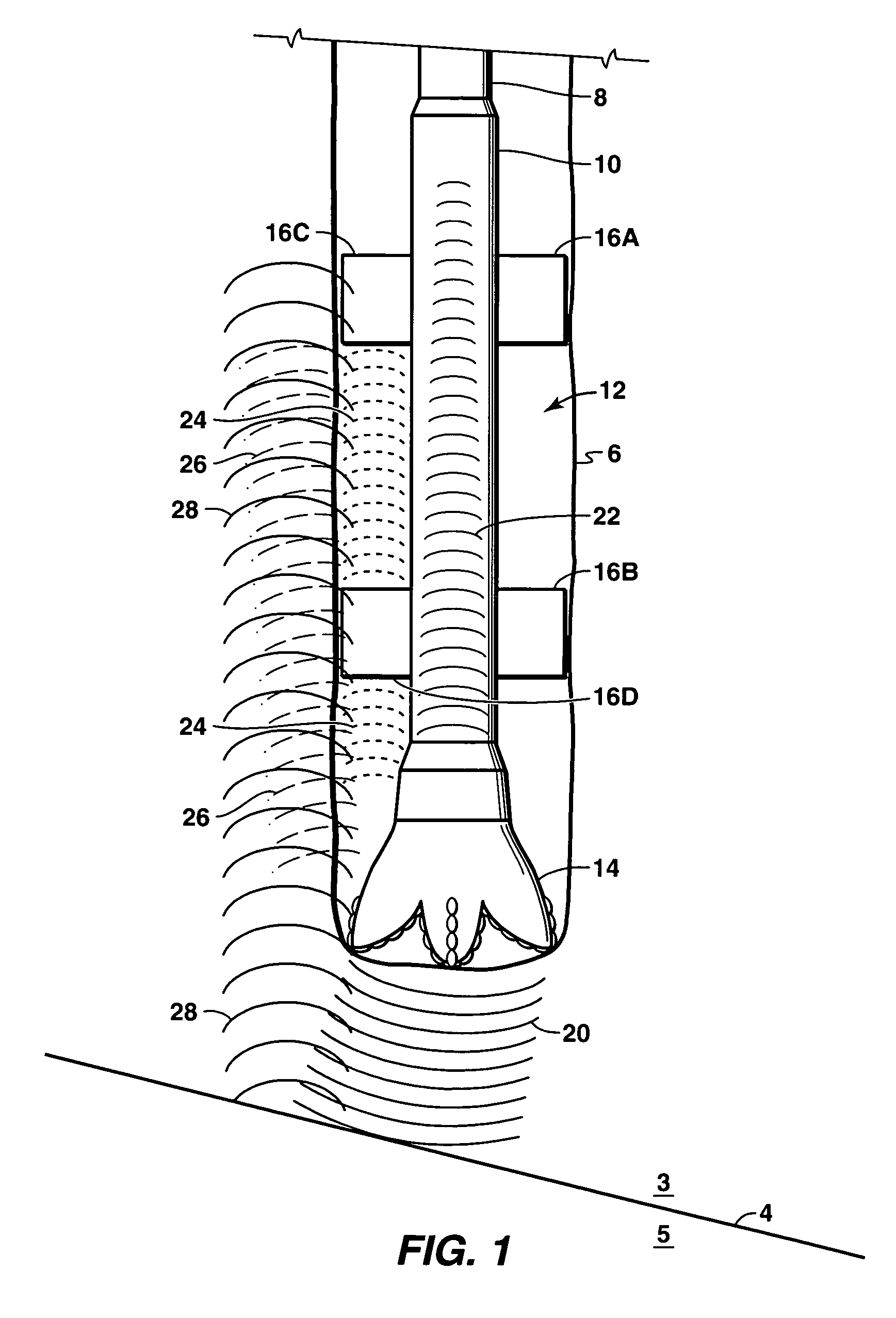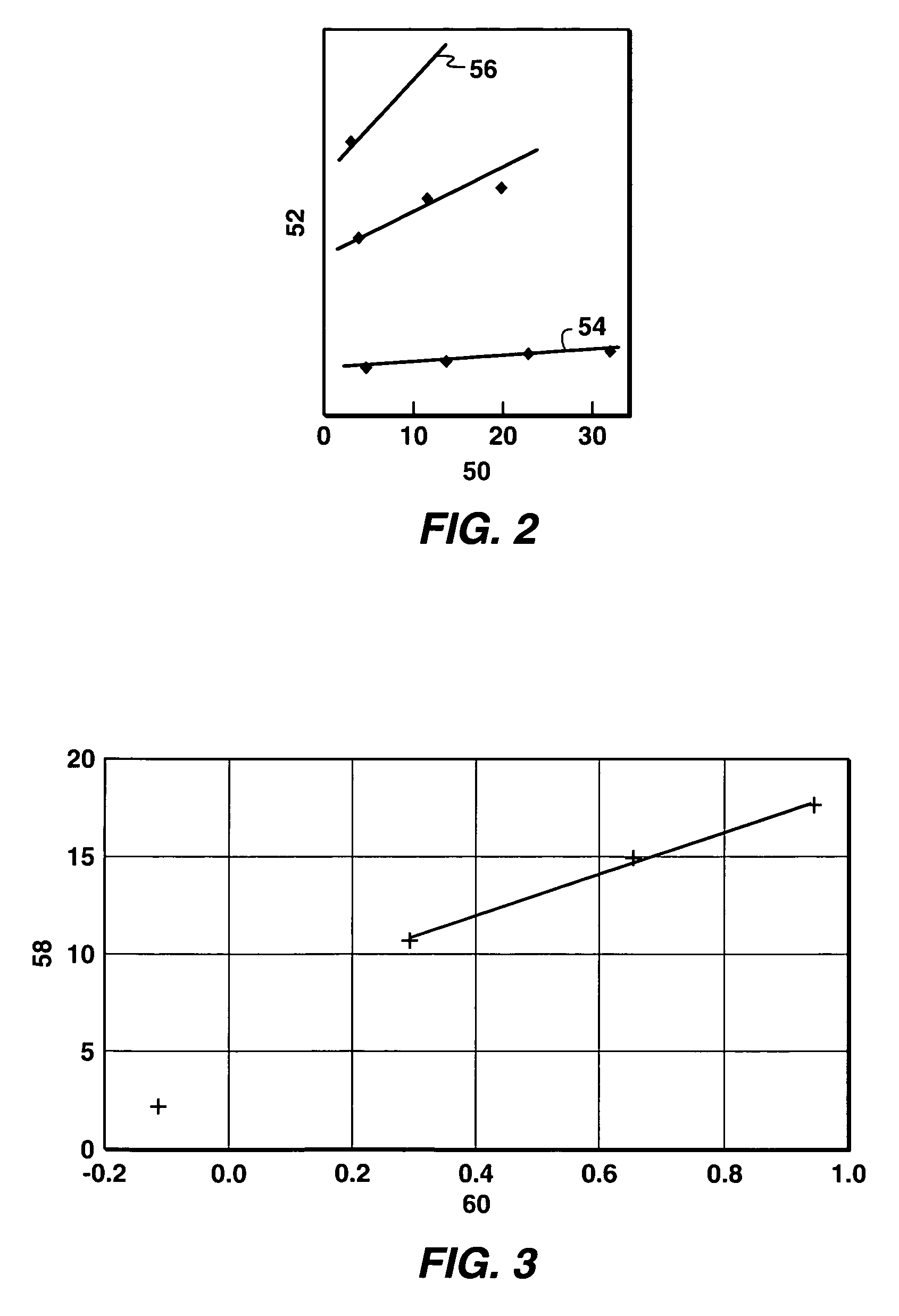Method for borehole measurement of formation properties
a technology of formation properties and measurement methods, applied in seismology for waterlogging, instruments, reradiation, etc., can solve problems such as unnecessarily reduced drilling rate, well blowout, and formation loss
- Summary
- Abstract
- Description
- Claims
- Application Information
AI Technical Summary
Benefits of technology
Problems solved by technology
Method used
Image
Examples
first embodiment
[0025]the present invention is depicted in FIG. 1. The measurement system of this embodiment includes a source for generating acoustic signals at or near the drill bit; a receiver array mounted on the BHA for detecting the signals generated by the source; hardware and software for signal processing, and a telemetry system for transmitting data to the drill rig.
[0026]The source for generating acoustic signals may be either passive or active. A passive source system will rely on the noise spectrum of the drill bit, which will typically involve large amplitude signals at frequencies up to about 20 kHz, to generate the source signal. The drill bit noise spectrum will generally have its highest amplitudes in the frequency of about 4 to about 6 kHz, and those amplitudes are typically far larger than the amplitudes of signals in the 10 to 100 Hz range which can be detected at the surface using seismic while drilling measurement techniques. The present invention teaches how to use these hig...
second embodiment
[0043]the method of the present invention allows estimation of pore pressure from the frequency-dependent change in velocity of the signals that propagate back to bottom hole assembly 12. Several mechanisms have been proposed to account for the frequency dependent wave propagation properties of fluid filled porous rocks, including the Biot slow wave mechanism and the squirt flow mechanism. In either case, both a frequency dependent velocity as well as a frequency dependent attenuation will result, and both will vary with the pore pressure. Thus, an alternate approach for estimating pore pressure ahead of the BHA is to measure the velocity of the waves traveling through the formation and reflected back to the receivers on the bottom hole assembly as a function of frequency. Following practices which are understood in the geophysical industry, wave propagation velocities as a function of frequency can be determined from the time of arrival of the wave front at the receiver and the emp...
third embodiment
[0044]the method of the present invention allows the estimation of pore pressure from the calculation of the ratio of the measured compressional wave velocity (υp) to the shear wave velocity (υs). Measured ultrasonic frequency data suggests that the ratio υp / υs increases by approximately 10% as the pore pressure increases from a negligible value up to the confining pressure. See for example, Christensen and Wang, 1985, “The Influence of Pore Pressure and Confining Pressure on Dynamic Elastic Properties of Berea Sandstone,” Geophysics, vol. 50, No. 2, pp. 207-213. The Christensen and Wang data relate changes in the conning and pore pressures in a formation to the Poisson's ratio. It will be understood to those skilled in the art that Poisson's ratio can be directly calculated from the ratio of the compressional wave velocity to the shear wave velocity. Thus, in this embodiment of the method of the present invention, pore pressure may be estimated by analysis of the compressional and ...
PUM
 Login to View More
Login to View More Abstract
Description
Claims
Application Information
 Login to View More
Login to View More - R&D
- Intellectual Property
- Life Sciences
- Materials
- Tech Scout
- Unparalleled Data Quality
- Higher Quality Content
- 60% Fewer Hallucinations
Browse by: Latest US Patents, China's latest patents, Technical Efficacy Thesaurus, Application Domain, Technology Topic, Popular Technical Reports.
© 2025 PatSnap. All rights reserved.Legal|Privacy policy|Modern Slavery Act Transparency Statement|Sitemap|About US| Contact US: help@patsnap.com



